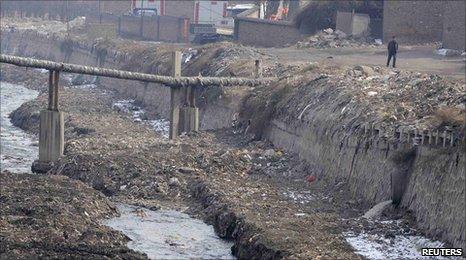What does China's new five-year plan address?
- Published

Chinese authorities say more attention will be paid to environmental issues
China's latest five-year plan for 2011 to 2015 seeks to achieve a more balanced approach to growth and development, focusing attention on the environment, livelihoods and what officials call "administrative reforms".
The 12th Five-Year Plan (FYP) is to be approved by the National People's Congress at its annual session beginning on 5 March.
The FYP is a key element in central planning. Copied originally from the Soviet system, it is an overarching strategy that shapes the nation's economic and social development.
It determines the allocation of resources among different sectors and industries, and sets rules for redistribution.
Since 1953, a total of 11 FYPs have been made and have expired, the targets they set for each period met or missed, and China's economy has grown to become the world's number two.
The Chinese policy-makers decided to replace the word "plan" with "guideline" in the previous five-year plan (2006 to 2010), to "reflect the transition from a centrally planned economy to a socialist market economy".
Replacing the word "plan", however, did not change the fact that it is still a model based on the political system of one-party rule.
It is still a state development programme initiated, formulated, implemented and managed by the government.
Environment focus
The latest FYP continues to advocate objectives set out in its three predecessors, such as to improve the quality of growth and to lay down the foundation for a moderately prosperous country.
In the current draft, environmental protection and energy conservation are identified as investment priorities.
This is backed up by specific targets: non-fossil fuel consumption should increase to account for 15% of the nation's total fuel consumption.
A projected $600bn (£370bn) is committed to growing sectors such as information technology, clean energy, environmental protection and scientific research and innovation, for example.
These steps are in line with the message from Environment Minister Zhou Shengxian earlier this week warning against unsustainable economic growth.
Mr Zhou said that the pursuit of rapid growth led to severe pollution and excessive demand for resources, two factors which in turn would become obstacles to economic and social development.
He suggested that the Ministry of Environment Protection be empowered to assess the environmental impact of future development projects.
Political will?
The 12th FYP also seeks to improve people's livelihoods, social infrastructure and safety nets, and to tackle rising inequality.
Expanding domestic consumption is seen by many as a key part of China's economic structural adjustment and achieving more balanced growth.
This is where many observers repeat a familiar line: the roadmap is clear but the political will to ensure targets are met is yet to be seen.
The fact that objectives such as "green growth" as set out in the previous FYPs reappear in the current one suggest that some administrative reforms are needed.
The authors of the 12th FYP admitted to local media that all goals spelt out in the plan pointed towards a more mature market economy and a more clearly defined, significantly reduced role of the state in the economy.
One of the reasons GDP growth has been less green than expected over the years, some argue, has to do with the state monopoly on resources and the single-minded pursuit of high GDP growth figures.
These have long been the only meaningful measurement of local government performance.
- Published28 February 2011
- Published27 February 2011
- Published14 February 2011
- Published6 January 2011
- Published25 November 2010